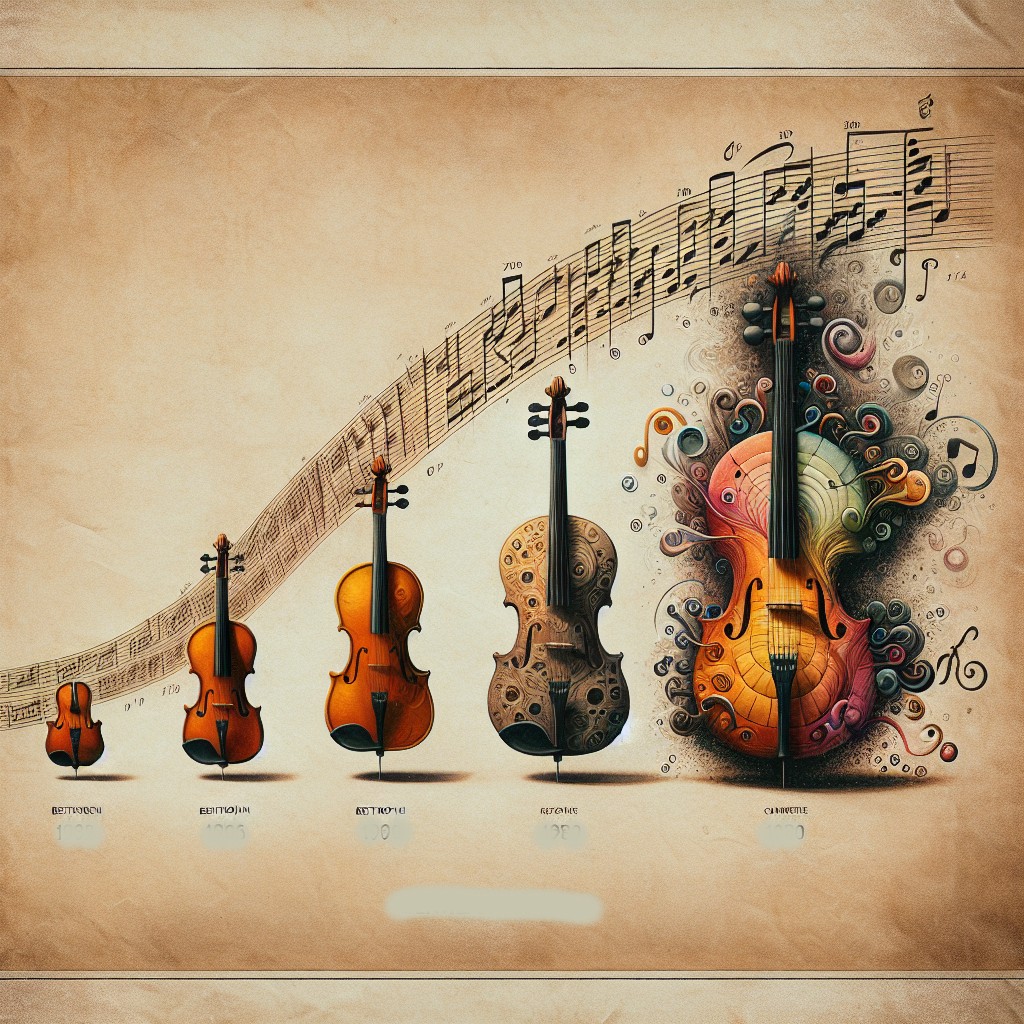
Beethoven’s Cello Sonatas: The Evolution of a Genre
Ludwig van Beethoven is a name synonymous with revolutionary change in the world of classical music. His works have served as a bridge between the Classical and Romantic eras, pushing the boundaries of musical composition and expression. Among Beethoven’s extensive body of work, his cello sonatas stand out as a significant contribution to the genre of chamber music. These sonatas offer a glimpse into Beethoven’s evolution as a composer, as well as his ability to innovate within established forms. Composed over a period of roughly twenty years, Beethoven’s five cello sonatas exhibit his experimental approach and deep insight into the capabilities of both the cello and the piano, making them a staple in the cello repertoire.
The cello sonatas are not just technical masterpieces; they are also deeply expressive works that convey a wide range of emotions and ideas. For the cellist, they provide ample opportunities to showcase technical prowess as well as musical sensitivity. For the listener, they represent a journey through Beethoven’s stylistic evolution, each sonata offering a unique glimpse into his creative mind at different stages of his career.
In examining Beethoven’s cello sonatas, we can see a clear progression in his style, from the early Sonatas Op. 5, composed during his youthful period in Vienna, to the mature and profound Op. 102 sonatas, written towards the end of his compositional output. Each sonata bears the distinct mark of Beethoven’s genius and offers invaluable insight into the development of chamber music during the late 18th and early 19th centuries.
Op. 5: Early Beginnings
The first two cello sonatas, Op. 5 No. 1 and No. 2, were composed in 1796 during Beethoven’s early years in Vienna. These works were dedicated to Frederick William II of Prussia, himself a skilled cellist, which likely influenced Beethoven’s decision to focus on the cello. The Op. 5 sonatas are characterized by their grand scale and innovative structure, departing from the traditional format of cello and accompanying basso continuo and instead treating the piano and cello as equal partners.
The first sonata in F major (Op. 5 No. 1) opens with a slow introduction, a feature that was uncommon in sonata form at the time. This leads into an Allegro movement filled with lively exchanges between the piano and cello, showcasing the virtuosic capabilities of both instruments. The second sonata in G minor (Op. 5 No. 2) follows a similar pattern, with a dramatic Largo introduction leading into an Allegro vivace replete with rhythmic drive and intensity.
These early sonatas not only highlight the technical skills required of both the cellist and pianist but also reflect Beethoven’s emerging style, characterized by bold themes, dramatic contrasts, and innovative use of form. The influence of Mozart and Haydn is evident, but Beethoven’s unique voice is unmistakably present, laying the groundwork for his future contributions to the genre.
Op. 69: Maturity and Innovation
Beethoven’s third cello sonata, Op. 69 in A major, composed in 1808 during his middle period, marks a significant evolution in his approach to the genre. This sonata is often regarded as one of Beethoven’s most lyrical works, reflecting his mature style that blends structural innovation with profound expressiveness. By this time, Beethoven had fully established his compositional voice, and the Op. 69 sonata demonstrates his ability to create intricate interplay between the cello and piano, with each instrument weaving in and out of prominence.
The sonata opens with a lyrical Allegro, where the cello introduces a theme that is passed between the instruments, showcasing Beethoven’s skill in thematic development and variation. The second movement offers a contrasting Scherzo, marked by its playful and rhythmic character. The sonata concludes with a rollicking Allegro vivace, featuring a dynamic conversation between the cello and piano that exemplifies Beethoven’s mastery of dialogue within chamber music.
The Op. 69 sonata highlights Beethoven’s ability to balance technical virtuosity with emotional depth, demanding both precision and expressiveness from the performers. This work stands as a testament to Beethoven’s mature style, blending Classical forms with the burgeoning Romantic expressiveness that would come to define his later works.

Op. 102: Late Style and Profundity
The final two cello sonatas, Op. 102 No. 1 in C major and Op. 102 No. 2 in D major, were composed in 1815, signaling Beethoven’s late period. These works are marked by their concentrated form, rich harmonic language, and profound expressiveness. The late sonatas reflect Beethoven’s introspective state, as he grappled with personal challenges, including his increasing deafness. This period is often associated with his most innovative and abstract compositions, and the Op. 102 sonatas are no exception.
Op. 102 No. 1 is notable for its compact structure, consisting of two movements. The first movement alternates between contemplative Adagio sections and a more energetic Allegro. The second movement features a fugue, showcasing Beethoven’s fascination with counterpoint and his skill in blending complexity with expressive clarity.
Op. 102 No. 2, on the other hand, includes three movements and is more expansive in form. The first movement, Allegro con brio, is energetic and rhythmically intricate. The slow middle movement serves as a contrasting meditation before leading into a final Allegro fugato, once again highlighting Beethoven’s absorption with fugal techniques and complex forms.
The Op. 102 sonatas are remarkable for their introspection and depth, requiring performers to delve into the emotional and intellectual intricacies of Beethoven’s late style. These works represent the culmination of Beethoven’s journey with the cello sonata, offering a profound conclusion to his contributions to the genre.
Impact and Legacy
Beethoven’s cello sonatas have left an indelible mark on the world of chamber music, influencing generations of composers and performers. By treating the cello and piano as equals, Beethoven expanded the expressive potential of the genre, paving the way for future innovations. His sonatas have become essential repertoire for cellists, offering a rich landscape of technical challenges and interpretive opportunities.
Beyond their technical and musical innovations, the cello sonatas also reflect Beethoven’s broader impact on classical music. His ability to infuse traditional forms with new expressive possibilities set a precedent for the Romantic era and beyond. Composers such as Brahms, Mendelssohn, and Shostakovich drew inspiration from Beethoven’s approach to chamber music, furthering the evolution of the genre.
For performers, Beethoven’s cello sonatas demand a high degree of technical proficiency and musical sensitivity. They require a deep understanding of the intricate interplay between the instruments, as well as an ability to convey the emotional and structural complexities of Beethoven’s writing. These works continue to challenge and inspire musicians, serving as benchmarks of artistry and craftsmanship.
Modern Interpretations and Performances
In contemporary times, Beethoven’s cello sonatas remain a cornerstone of the chamber music repertoire, frequently performed and recorded by leading cellists and pianists. Each generation of musicians brings its own perspective to these works, offering fresh interpretations that highlight different aspects of Beethoven’s genius. Modern performances often draw on historical research and period instruments to recreate the sound world of Beethoven’s time, providing listeners with a deeper understanding of his music.
Recordings by renowned cellists such as Yo-Yo Ma, Mstislav Rostropovich, and Jacqueline du Pré have brought Beethoven’s cello sonatas to a global audience, ensuring their place within the classical canon. These performances offer a range of interpretive approaches, from historically informed renditions to more modern, expressive interpretations, each shedding new light on the intricacies of Beethoven’s writing.
The continued relevance of Beethoven’s cello sonatas in the concert hall and recording studio speaks to their enduring significance and appeal. As musicians and audiences continue to explore these works, Beethoven’s legacy as a pioneering composer and innovator in chamber music remains firmly intact.
Conclusion
Beethoven’s cello sonatas stand as a testament to his exceptional talent and innovative spirit. Spanning his early, middle, and late periods, these works offer a comprehensive view of his stylistic evolution and contributions to the genre of chamber music. From the grand and ambitious Op. 5 sonatas to the profound and introspective Op. 102 sonatas, Beethoven’s cello works showcase his ability to expand the expressive potential of the cello-piano duo, transforming the genre and leaving a lasting legacy.